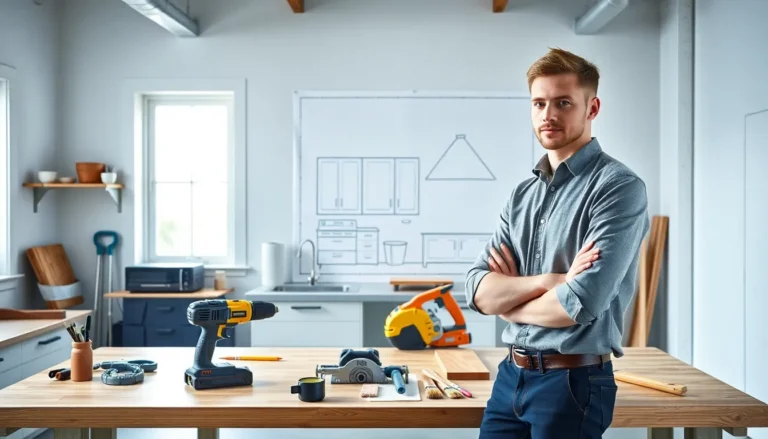Table of Contents
ToggleAre you staring at those outdated walls, wondering how on earth you can turn your home into a masterpiece? Let’s face it: DIY home renovation can feel like a daunting Everest of challenges. Fear not. With the right tips in your toolbox, you’ll be smashing through walls, figuratively, we hope, like a seasoned contractor. Grab your paintbrush and put on your tool belt because, with these smart strategies, you’ll transform your living space without transforming it into a chaotic disaster zone. Here’s the ultimate guide to DIY home renovation that is clear, knowledgeable, and just the right amount of sassy.
Planning Your Renovation

Setting a Budget
Before diving headfirst into the exciting world of home renovation, it’s crucial to set a budget. Picture this: you’ve got the vision of that dreamy kitchen, but once you start checking prices, you realize you’ve accidentally set your sights on a Ferrari rather than a Ford. To avoid an epic budget meltdown, break down your overall budget into categories: materials, tools, labor, and a cushion for unforeseen surprises. Always allocate at least 10% for those unexpected costs that seem to pop up like weeds in your garden.
Choosing the Right Projects
Next up is project selection. Not all renovations are created equal. Assess your living space and pinpoint areas that scream for improvement. Focus on projects that increase your home’s value, such as kitchen upgrades or bathroom overhauls. Projects that enhance functionality or curb appeal can offer a solid return on investment. So, pick wisely, and remember: just because you saw it on Pinterest doesn’t mean it’s the best project for you.
Creating a Timeline
Now that the budget is set and projects are decided, creating a timeline is essential. A well-structured timeline will help you stay organized and on track. Start by listing each project in order of priority, then estimate how long each task will take. Don’t forget to factor in time for unexpected delays, after all, renovations have a penchant for running off schedule. Stick to your timeline as closely as possible, but stay flexible when things go sideways: they often do.
Essential Tools and Materials
Must-Have Tools for Beginners
Every DIY enthusiast knows that having the right tools can make or break a project. For beginners, investing in a solid toolkit is crucial. A basic toolkit should include a tape measure, level, hammer, screwdrivers, pliers, and a drill. As projects advance, you might want to add tools like a jigsaw, circular saw, or nail gun to your arsenal. Remember, quality tools can save time and frustration, so spend wisely when shopping.
Choosing Quality Materials
Equally important to the tools is the choice of materials. Not all materials are made equal, especially when it comes to long-term performance. Researching product reviews and asking for recommendations can lead you to the best options. Whether you’re perusing paint swatches or flooring samples, always opt for materials that offer durability as well as aesthetics. Do yourself a favor: don’t skimp on quality, because a shoddy material will haunt you faster than that unfinished basement.
Safety Considerations
Protecting Yourself and Your Home
As exhilarating as it is to renovate, safety should be your top priority. Always don protective gear, including goggles, gloves, and masks, particularly when dealing with dust or chemicals. Ensure that your workspace is clear of clutter, and keep tools organized to reduce accidents. If you’re tackling major renovations, know how to shut off utilities like water and electricity, so that you’re not left in the dark, literally.
Understanding Renovation Risks
Every renovation comes with its risks, from structural issues to hazardous materials like asbestos. Awareness is key to navigating these risks smoothly. Conduct thorough inspections of your home before starting any major work, and familiarize yourself with local building codes and regulations. Educating yourself on potential dangers will help you avoid costly mistakes and ensure a safe renovating experience.
Execution of Your Projects
Following Step-by-Step Guides
With all the prep work done, it’s time to execute your projects. Lean on step-by-step guides, there’s no shortage of resources available online. Video tutorials can be particularly helpful, as they give a visual representation of processes. Always take it one step at a time, and don’t rush. Each small victory will keep your morale high as you watch your space transform into something amazing.
Knowing When to Call a Professional
But, there comes a time when DIY just isn’t enough. If you encounter challenges that feel overwhelming, don’t hesitate to call in a professional. Whether it’s electrical work, plumbing, or major structural issues, some tasks are best left to those who know what they’re doing. Hiring a pro can save you time and headaches down the road, after all, nobody wants to deal with a DIY disaster.
Finishing Touches and Clean-Up
Adding Personal Style
Now the fun really begins. After the heavy lifting is done, it’s time for those finishing touches that reflect personal style. Think about paint colors, furnishings, and accessories that enhance your newly renovated space. These details are what turn a house into a home. After all, what’s more rewarding than sipping coffee in a beautifully transformed kitchen that you brought to life?
Final Clean-Up Tips
After all is said and done, cleaning can feel like an afterthought. But a thorough clean-up is essential to finalize your renovation. Take the time to wipe down surfaces, vacuum dust, and dispose of any leftover materials responsibly. A sparkling clean home is the cherry on top of your DIY sundae, making all your hard work worth it.







